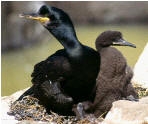|
| |
|
Effects of
the Prestige oil spill on populations. The case of the European shag |
|
|
European shag is the second most numerous
seabird breeding in Galicia. The breeding population is quite dispersed
although Illas Cíes held the most important colony, approximately 42% of the
Iberian population and 2% of the world population. During the last decade the
Iberian shag population showed an overall decline at an annual rate of 5%,
attributed to elevated adult mortality in gill-nets, and was listed as
endangered in the Red Book of the Birds of Spain. This species is an inshore
and coastal feeder, feeding predominantly on pelagic and benthic fish, and
resident throughout the year, so with great opportunities for oil exposure as
long as the oil persists in their foraging areas, thus shags are good models
to study the effect of the Prestige oil spill in the ecosystem. |
  |
|

|
One of the main problems in detecting
population effects related to oil spills is that seabird populations show
spatial and temporal fluctuations for a number of different reasons, whose
effects may be difficult to disentangle. The existence of pre-spill data for
population parameters of European shags at oiled and unoiled colonies in the
Iberian Peninsula allowed the use of temporal and spatial replicated design (known
as before-after-control-impact [BACI] design). By comparing population
dynamics before and after the spillage event it is possible to distinguish
between effects of the Prestige oil spill and natural and spatial variation.
|
|
Using this design, it was possible to observe
that, colonies located within the path of the oil suffered greater declines (ca.
10%) compared with pre-spill trends and with population trends at unoiled
colonies (Velando et al. 2005b), indicating that the Prestige oil spill
affected European shag at the population level. Although a complex effect of
the direct mortality on population was detected (Martinez et al. 2006), factors affecting the reproductive success were also evident. The breeding
success was 50% lower in oiled colonies compared with unoiled colonies but the
annual reproductive success did not differ among colonies before the impact
(Velando et al. 2005a,b).
The effect at population level documented in the European shags breeding
at colonies within the oil path highlights that the effect on marine organisms
are complex and long-lasting. Indeed, as a result, the future recovery of
endangered shags could be jeopardized owing to continuous exposure to oil
through food webs and reduced food availability as documented in this and
other seabirds. There is a risk that the impacts of oil pollution on marine
organisms may be underestimated by overlooking the effects of chronic
exposures, delayed impacts or indirect effects driven by ecological processes. |

|
|
|
|
REFERENCES |
 |
Martínez-Abraín, A., Velando, A., Genovart, M., Gerique, C., Bartolomé, M.A.,
Villuendas, E., Sarzo, B., Oro, D., 2006. Sex-specific mortality of European
shags during an oil spill: demographic implications for the recovery of
colonies. Mar. Ecol. Progr. Ser. 318, 271–276 |
 |
Velando, A., Munilla, I., Leyenda, P.M., 2005a. Short-term indirect effects of
the Prestige oil spill on a marine top predator: changes in prey availability
for European shags. Mar. Ecol. Progr. Ser. 302, 263–274. |
 |
Velando, A., Alvarez, D., Mouriño, J., Arcos, F., Barros, A., 2005b.
Population trends and reproductive success of European shag following the
Prestige oil spill in the Iberian Peninsula. J. Ornithol. 146, 116–120.
|
|
|
 Alberto Velando. Universidade de Vigo
Alberto Velando. Universidade de Vigo |
|
|
